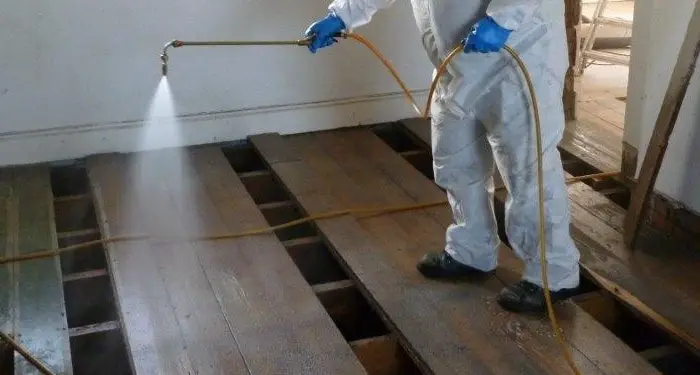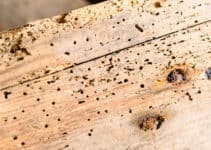Professional woodworm treatment is pretty much guaranteed to get rid of an infestation, for a while at least.
As such, it’s fair to ask, can woodworm come back after treatment? Woodworm can come back after treatment for a few reasons. First, the treatment might not have killed them all. Second, it could be a completely new infestation. The only way to really prevent this from happening is to remove the conditions that made them breed in the first place.
Below, we’ll look at why a woodworm infestation might come back, how long this might take, and what you can do about it.
Does Woodworm Come Back After Treatment?
Woodworm can come back after treatment if it wasn’t done properly. For example, if some eggs were missed, nothing is stopping them from hatching and breeding as if they weren’t even treated.
However, we’d like to assume that professional exterminators can get rid of an entire infestation in one treatment cycle.
Also, we can’t overlook the fact that woodworm coming back could simply be a new infestation. This is unlikely if proper chemicals are used because they can prevent infestations from happening for a long time.
However, if you use household treatments, you might find they don’t prevent future problems but rather deal with the existing ones.

How Long Does Woodworm Treatment Last?
If done properly, woodworm treatment can last for up to 20 years. The chemicals are pretty strong and create a protective layer over the wood that stops woodworm from burrowing in.
Provided you get it done professionally, you shouldn’t have to worry about the woodworm coming back.
Is it Common for Woodworm to Come Back?
It’s not particularly common for woodworm to come back after an area has been treated, but this ultimately depends on the method and quality of the treatment.
Without going into too much detail, a surface treatment won’t prevent woodworm from living in the timber, which will increase the likelihood of the problem returning.
And, again, it depends on what you use to treat the woodworm. If you only use household chemicals, the chances of woodworm coming back are quite high.
However, if you hire a professional, the chances are very low, provided they know how to do their job.
But it’s also worth noting that we shouldn’t consider the infestation to have returned until the existing woodworm have completed their life cycle. This can be as long as 5 years for the full life cycle.
As such, you could see living woodworm that are part of the infestation you had treated and it could still be considered successful.
An exterminator is unlikely to come and apply more treatment until the first one has done its job properly.

How Do You Keep Woodworm from Coming Back?
Unsurprisingly, the best form of treatment is prevention when it comes to woodworm. If you get a professional treatment done, you should take some steps to prevent it from coming back. These include:
1. Using the right treatment
It should be obvious by now that the type of treatment you use matters. If you’re concerned about it coming back, speak to an exterminator and explain your needs.
They should be able to choose the most appropriate solution based on your home and the extent of the infestation.
2. Improve the area
Woodworm like areas with a high moisture level, such as attics. To prevent an infestation from coming back, you should address the issues that led to it being there in the first place.
The easiest thing to change is an area’s moisture level. For example, if it’s in your attic, you should consider chemically treating the wood as an initial step.
Then, improve the area’s ventilation to reduce moisture. You can do this using a dehumidifier, a fan, or simply by opening the area up.
Ideally, the area should have a moisture level of 20% or less if you want to prevent woodworm from coming back.
3. Be prepared to make changes
You won’t necessarily need to remove damaged timber after it’s been treated. This ultimately depends on the extent of the damage, but the job will be a big one. Unless its a garden shed which can cheaply be replaced.
As such, it’s good to avoid having to replace timbers.
However, you might be best to get rid of furniture that’s been infested. The timber used in furniture is thinner, meaning the damage is more obvious and could result in the furniture being unusable.
Final Thoughts
Hopefully, this article has helped you figure out what might be going on with your treated woodworm infestation.
The important takeaway is that the treatment has probably worked, even if you’re seeing woodworm a while after it happened.
Provided you take some preventative measures, it shouldn’t come back either.



